Turkey Island Hopping Guide: Discover the Best Islands to Visit
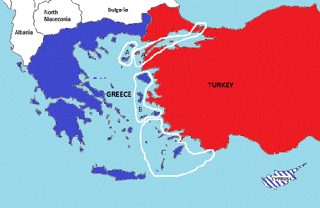
In your quest for a perfect summer escape, a place steeped in history, or to witness some of the most breathtaking coastal vistas of the Aegean and Mediterranean Seas, look no further than the diverse islands of Turkey.
Each island stands as a unique destination, with some transforming into bustling hubs of summer activity. Others offer a more tranquil experience, perfect for a day of exploration or a serene sightseeing stop during your journey.
Even amidst the vast urban landscape of Istanbul, a group of islands awaits, just a short ferry journey away. These islands provide a refreshing, laid-back respite from the hustle and bustle of city life.
To tailor your Turkish adventure, delve into our curated selection of the finest islands Turkey has to offer.
Bozcaada
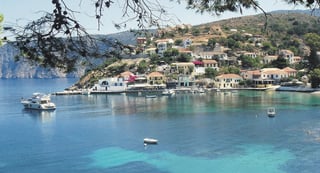
For those residing in Turkish cities and seeking a sophisticated and stylish beach retreat, this island, nestled south of the Dardanelles in the Aegean Sea, offers a tranquil escape. Historically known as Tenedos, this locale became a part of Turkey in 1923. Despite the turbulent history involving the Greek community of Bozcaada during the 1960s and 70s, the island's rich Ottoman Greek legacy endures, particularly in the well-preserved architecture of Bozcaada Town.
Lovers of classical myths will find intrigue here: the Aeneid recounts how the Greeks used Tenedos as a strategic hideout, facilitating their infamous Trojan Horse ruse.
With a modest year-round population of around 3,000, Bozcaada truly comes to life from June to September. On summer weekends, it's a favorite among Turks for basking on the sun-kissed Ayazma Beach to the south or embracing water sports at the breezy Cayır Beach in the north.
Bozcaada offers a serene pace of life, ideal for those who prefer a laid-back vacation. Visitors often enjoy leisurely strolls through the historic Greek quarter or explore the Byzantine-era castle in Bozcaada Town, the island’s central hub.
Accommodations on the island are predominantly upscale and boutique, with most closing outside the summer season. Advance booking is highly recommended during the peak months due to limited availability and the island's popularity.
Access to Bozcaada is convenient, with year-round car ferry services from Geyikli (54 kilometers southwest of Çanakkale) and a summer-only passenger hydrofoil ferry from Çanakkale.
Gökçeada
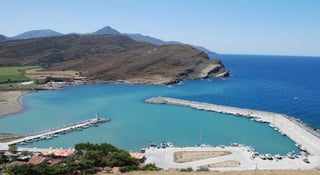
Gökçeada offers a quintessential experience of serene, rural island life, unmatched in its appeal. Nestled west of the Gallipoli Peninsula in the Aegean Sea, this charming island awakens to its full vibrancy during the bustling summer months. Yet, it's in the quieter times outside the peak season that Gökçeada truly shines as a haven for those who cherish nature and seek tranquil beach retreats.
Much like its counterpart Bozcaada, Gökçeada boasts a historical tapestry richly woven with its Ottoman Greek origins, once known by its Greek name, Imbros. The 1960s saw a turbulent period for its Greek residents, leading to a mass departure. Today, the island's landscape is dotted with deserted villages, their stone architecture and cobblestone paths standing as poignant testaments to its complex past and Greek legacy.
The island's southern coast, with its idyllic beaches like Aydıncık and Kapıkaya, becomes a sanctuary for leisure seekers in the summer. Aydıncık, in particular, is a favored spot for windsurfing enthusiasts. In contrast, the cooler months of winter and spring attract nature lovers, eager to witness the pink flamingoes at the island's salt lake. For the adventurous, mountain biking through Gökçeada's rugged interior and exploring its historic villages is a popular activity.
Accommodations on Gökçeada are diverse, ranging from cozy, family-operated boutique hotels and pensions to a few larger establishments, offering a warm, intimate stay. Connectivity to the mainland is seamless, with regular car ferries operating year-round from Kabatepe on the Gallipoli Peninsula and a passenger-only ferry service from Çanakkale twice a week. This blend of natural beauty, rich history, and accessible tranquility makes Gökçeada a cherished destination for island enthusiasts.
Cunda
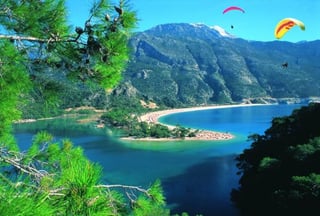
Cunda Island, often referred to as Alibey Island, lies just a stone's throw from Ayvalık on the North Aegean Coast. This picturesque island is seamlessly connected to the mainland via a causeway, making it effortlessly accessible.
Historically, Cunda was home to an Ottoman Greek population, which became part of the population exchange between Turkey and Greece in the 1920s, as dictated by their peace treaty. This exchange led to the displacement of these residents to Greece, while ethnic Muslims from Crete were resettled on the island.
The island's old town is a treasure trove of Ottoman Greek architectural heritage, offering an ideal backdrop for leisurely exploration. Among its architectural gems is the Greek Orthodox Church of the Archangels, now repurposed as a museum, standing as the town's most distinguished structure.
Culinary enthusiasts often visit Cunda from Ayvalık, drawn by its exceptional dining scene. The local cafés and restaurants, predominantly situated around the old town harbor, serve a fusion of Cretan and Turkish culinary traditions, epitomizing Aegean cuisine.
On the western flank of Cunda lies the Ayvalık Adaları Nature Park, a protected area. Here, a trail meanders through pine forests leading to an ancient Greek Orthodox monastery. This side of the island is also known for its inviting beaches, frequented by both those on boat tours from Ayvalık and visitors staying on Cunda.
While many choose to visit Cunda as a day trip from Ayvalık, the island does offer various accommodations, including quaint hotels, pensions, and some boutique hotels. One such charming place is Orchis Otel, nestled in a traditional stone house merely 50 meters from Ayvalık harbor and the Cunda ferry link. The hotel beautifully blends modern boutique aesthetics with traditional elements, while preserving the original architecture to maintain its historical allure.
Transport to Cunda is both convenient and frequent, with regular ferries running between Ayvalık and Cunda harbors. Additionally, minibusses are available, offering a quick journey across the causeway to either the island's beaches or Cunda harbor.
Heybeliada (Princes' Islands)
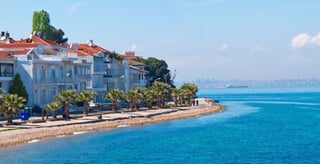
Escape the hustle of Istanbul and immerse yourself in the tranquility of the Princes' Islands, a favorite retreat among the locals. Board a ferry and set sail to Heybeliada, nestled in the Sea of Marmara and renowned as the archipelago's second-largest gem.
Visit Heybeliada between May and October, and you'll find it buzzing with Istanbulites seeking solace. However, to truly experience the island's serene charm, consider a weekday jaunt, as weekends often draw large crowds.
Embrace the unique, car-free environment of Heybeliada. Traverse its landscape on foot or cycle through the scenic routes — bike rentals are readily available. The island beckons with its narrow lanes, flanked by majestic wooden villas, leading to vantage points offering breathtaking sea vistas.
Frequent ferries connect central Istanbul to the tranquil shores of Heybeliada. While overnight stays are an option, thanks to a modest selection of accommodations, most visitors opt for a rejuvenating day trip, returning to the mainland with cherished memories.
Kızkalesi Island

Nestled along Turkey's southern coast, caressed by the Mediterranean Sea, lies the charming beach town of Kızkalesi, a hidden gem favored by domestic tourists. The town's name, translating to "Maiden's Castle," is derived from a small, picturesque island situated just a short distance from the shoreline.
The island of Kızkalesi is home to the striking ruins of a Byzantine-era castle. This historical fortress, renowned for its well-maintained ramparts and imposing towers, rises majestically from the rugged island terrain, creating a breathtaking silhouette against the coastal backdrop.
Visitors eager to delve into the castle's storied past will find the interior mostly in ruins, with the main allure being the formidable, ancient walls. To reach this historical treasure, regular boat services ply the waters, offering a scenic journey from the beach to the island.
For the more adventurous, the island's proximity to the shore, a mere 300 meters away, presents a unique opportunity. Those up for the challenge can indulge in a refreshing swim from the mainland to the castle, immersing themselves in the natural beauty and rich history of this enchanting location.
Gemiler Island

Gemiler, often referred to as St. Nicholas Island, stands out as a sought-after destination for day-long boat excursions from Ölüdeniz’s sandy shores, as well as for extended yacht journeys that navigate along the coastline starting from Fethiye.
This island is home to the remnants of five churches dating back to the Byzantine period, nestled among its rugged hills. These ruins, alongside ancient tombs and fragments of other ecclesiastical structures, beckon history enthusiasts to explore on foot. However, many visitors prefer the leisure of admiring these historical treasures from the comfort of their boats.
The island's moniker in English is inspired by a theory held by some scholars: Gemiler might have been the site of the original resting place of St. Nicholas, better known as Santa Claus. This revered figure, born in Patara, later ascended to the position of Bishop in Myra, present-day Demre.
For those wishing to venture to the island independently, bypassing group excursions, the pebbled Gemiler Beach is the starting point. Located directly across from the island, here one can find small motorboats offering round trips to the island and the option to rent kayaks, providing a more intimate and personal exploration of Gemiler.
Büyükada (Princes' Islands)
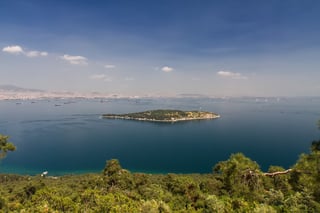
Büyükada stands as the largest among the Princes' Islands and is a favored getaway from the bustling life of Istanbul. While its charm tends to be somewhat overshadowed by the influx of visitors during peak summer, it's still not an entirely tranquil retreat. Opt for a midweek visit between May and September or choose the milder seasons of spring and fall for an optimal experience.
The island's coastline features numerous beaches, but Büyükada's true allure lies in its pedestrian-friendly paths flanked by opulent villas from the 19th century. A walk up the hill to St. George's Monastery offers breathtaking vistas of the Marmara Sea and Istanbul's skyline.
Historically, Büyükada has been a notable place of exile. Leon Trotsky spent his initial years of banishment from the USSR here. During the Byzantine period, a convent on the island served as a secluded retreat for exiled empresses. To delve deeper into Büyükada's rich history, including that of the other islands in the group, a visit to the Museum of the Princes' Islands is a must.
Regular ferry services connect Istanbul with Büyükada, making it easily accessible. The island hosts several accommodation options, including hotels set in beautifully restored wooden villas. An overnight stay is highly recommended to fully appreciate the island's serene ambiance after the day tourists have left.
For those seeking a luxurious stay, the Ada Palas is the pinnacle of elegance on the island. Renowned as one of Turkey's most romantic hotels, this exquisitely refurbished wooden villa features rooms decorated in a majestic 19th-century style and is home to one of Büyükada's most acclaimed restaurants.
Akdamar Island
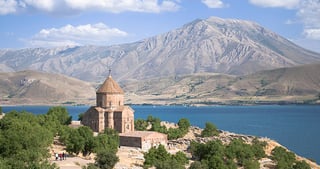
Akdamar Island, nestled in the heart of Lake Van, hosts the renowned Church of the Holy Cross, a jewel of historical significance. The island, situated a mere three kilometers from the rugged southern shores of the lake, was once the epicenter of a larger spiritual complex. This architectural marvel dates back to the 10th century, a testament to King Gagik Artzruni's reign over the Armenian Kingdom of Vaspurkan.
Venturing inside the church, visitors may encounter remnants of frescoes. Though their preservation is not optimal, they still hold historical value. However, the true masterpiece lies in the church's exterior. The outer walls boast an array of exquisitely detailed stone reliefs, immaculately preserved over centuries. These carvings vividly narrate stories from the Old Testament, placing the church's façade among the most significant examples of Armenian artistry.
Access to this historic island is primarily via tourist boats. These boats embark on round trips from Akdamar Harbor, located near Gevaş village on the lake's southern bank,approximately 45 kilometers west of Van. The departure of these boats hinges on reaching full capacity, making it advisable for visitors to join a guided tour from Van. This strategy not only increases the likelihood of a fuller boat but also minimizes waiting time.
During the winter and early spring, when tourism in Van slows considerably, regular tourist boat services become scarce. In such cases, visitors might find themselves needing to arrange private boat hire to explore this enchanting island and its storied church.
Pigeon Island

Constructed as a protective fortress during the Byzantine period, the Kuşadası Castle stands majestically on Pigeon Island (Güvercin Adası), a short distance from the shores of the bustling resort town of Kuşadası.
Currently, this castle is a striking feature on the coastline, offering a glimpse of history in a location predominantly known for its cruise ships and vibrant beach vacation atmosphere.
The structure that greets visitors today largely stems from the Ottoman period. During this time, the castle's fortifications underwent significant expansions and renovations, a testament to its role as a vital hub in the Mediterranean's commercial network.
Visitors can reach the island via a connecting causeway. Once on the island, a scenic footpath follows the old castle walls, providing a unique historical journey. The castle's interior has been transformed into a landscaped park. Here, informative panels are strategically placed, offering insights into the local plants and wildlife specific to the Kuşadası region.
This site serves as an ideal spot for an evening walk, where one can enjoy the beauty of the ancient ramparts against the backdrop of the stunning coastal scenery.
Kekova Island
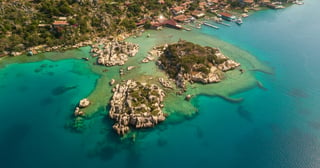
Visitors are drawn to Kekova Island not merely for its land, but primarily for the marvels submerged along its coastline.
Here, voyagers—whether aboard boats or gliding through in sea kayaks—gather to gaze upon the underwater relics of ancient Dolchiste, now known simply as "the sunken city." This historical gem was lost to an earthquake in the 2nd century.
The region surrounding Kekova is a tapestry of wonders, boasting one of the most breathtaking coastlines in Turkey. The harbor of the village Kaleköy, facing the island, is dotted with partially submerged tombs. Above Kaleköy, a fortress stands sentinel, amidst the vestiges of old Simena.
While many explore this area through tours starting from Kaş, located 33 kilometers to the west,Kaleköy and the neighboring harbor village of Üçağız (just four kilometers west) offer a more serene experience. Here, nestled in these quaint locales, is a selection of boutique hotels and pensions, perfect for those seeking a peaceful rural escape.
Kızkulesi
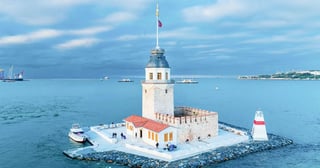
The Maiden's Tower, an emblematic structure in Istanbul, stands elegantly on a tiny islet at the junction of the Bosphorus Strait and the Sea of Marmara. This tower, known as Kızkulesi in Turkish, embodies a rich tapestry of history and culture.
Tracing its roots back to the Byzantine period, the tower initially served as a strategic fortification for Constantinople, safeguarding the city's aquatic gateways. The iteration we see today, steeped in architectural finesse, was constructed in the 18th century.
Currently, the Maiden's Tower is more than a historical monument; it houses a charming café-restaurant. This spot is not just about culinary delights; it's a portal to some of the most breathtaking views of the city, making it a must-visit destination for both locals and tourists alike.
For those wishing to experience this marvel up close, boats regularly set sail from Üsküdar, located on the Asian side of Istanbul. The journey offers a unique perspective of the tower. Additionally, the area around the boat ticket office in Üsküdar, lined with cozy cafés, provides an alternative viewpoint to appreciate the tower's majestic presence, blending seamlessly with the city's skyline.
Burgazada
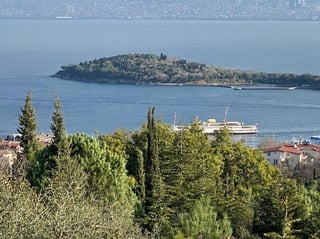
Burgazada, affectionately known as 'Burgaz' by its inhabitants, translates to "fortress". This charming island, part of the Princes' Islands cluster, boasts a rugged terrain interspersed with patches of forest. It's renowned for its splendid, well-frequented beaches and a plethora of historic landmarks, including a mosque situated just beyond the central square.
Exploring Burgazada reveals hidden gems like Kalpazankaya, a secluded beauty spot, and the Sait Faik Museum. Sait Faik Abasıyanık, a celebrated Turkish writer known for his short stories and poems, drew inspiration from the serene ambiance of the island. In Kalpazankaya, visitors can find a bronze statue of him at his favored eatery, gazing out over the landscape with a glass of Rakı in hand, which is ceremoniously refilled each day.
Nestled on the island's western side, Kalpazankaya Plajı is a quaint spot with simple wooden tables and chairs shaded by pine trees, offering a breathtaking view of the sea. It's an ideal place for a casual lunch or to watch the sunset.
The island's highest point, Flag Hill, offers a magnificent panoramic view encompassing the surrounding islands and the Anatolian mainland coast.
Another notable site is the Burgazada Sanatorium, established in 1928, marking it as one of Türkiye's most historic sanatoriums. Additionally, the island is a hub for various water sports, especially around its rocky beaches and waterfront areas.
Kınalıada
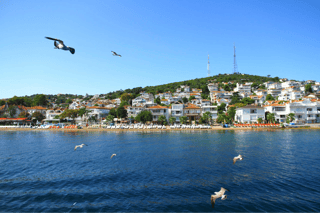
Kınalıada, the smallest gem in the archipelago, spans a quaint 1.3 square kilometers. Its Turkish name, evoking the rich hues of henna, hints at the island's unique reddish terrain—a characteristic attributed to either copper deposits or the native flora. Here are some additional insights into Kınalıada, setting the stage for exploring its offerings.
This charming island is crowned by three scenic hills: the serene Çınar Hill, the majestic Teşrifiye Hill, and the historic Manastır Hill, each offering breathtaking vistas. Kınalıada's landscape, marked by sparse vegetation and rocky soil, is a treasure trove of diverse minerals. Historically significant, its stones have been the foundation of monumental constructions, including the Byzantine-era walls of İstanbul and notable 19th-century structures like the Tophane Dock and Haydarpaşa Port.
Modern amenities like electricity and water systems were introduced much later in Kınalıada's timeline. The electricity grid came to life in 1946, while a reliable water supply, previously ferried from İstanbul by tankers, became a reality only in 1981. Despite its modest size, Kınalıada is a melting pot of cultures, housing about two thousand year-round residents. This number swells to approximately 20,000 during the summer months, reflecting its appeal as a seasonal haven.
Accommodation on the island blends quaint charm with comfort, featuring a few boutique hotels and cozy, pristine hostels. Kınalıada's proximity to İstanbul makes it an idyllic destination for those seeking a tranquil, convenient escape from the city's hustle and bustle.
Kalem Island
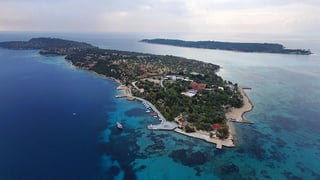
Kalem Island, known in Turkish as Kalem Adası or "Pen Island," is a picturesque isle nestled in the Aegean Sea, falling under the jurisdiction of the Dikili district in Turkey's İzmir Province. Its coordinates place it at a strikingly precise location of 9°0′12″N 26°47′42″E.
Situated tantalizingly close to the quaint town of Bademli, the island is just a short 400-meter (around 1,300 feet) journey from the Anatolian mainland. This slender stretch of land boasts a modest length, extending approximately 1.5 kilometers (about 0.93 miles) from its northernmost to the southernmost tip.
Steeped in a rich historical tapestry, Kalem Island, alongside the nearby Garip Island, was once known as the Arginusae islands, a name derived from ancient Greek: Ἀργινούσαι, Arginóusai.
These islands played a pivotal role as the backdrop for the historic naval battle of Arginusae, a significant conflict that unfolded in 406 B.C.
In contemporary times, Kalem Island has transformed into a privately owned oasis. It now hosts a welcoming hotel and a serene beach, catering to both tourists and diving enthusiasts, offering a blend of historical intrigue and modern leisure.
Marmara Island
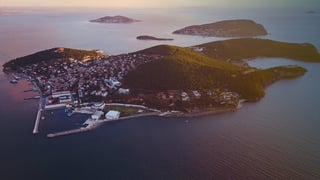
Nestled in the heart of the Sea of Marmara, the Marmara Islands (locally known as Marmara Adaları) form a captivating archipelago. Situated in the sea's mid-western region, these islands are conveniently positioned near the Dardanelles, also known as the Gallipoli Straits, on the Asian coastline.
This charming cluster comprises four distinct islands, each with its unique allure. The largest, Marmara Island, is an embodiment of natural diversity, boasting rugged, wind-swept hills in the north and serene pine forests in the south. Avşa Island, famed for its inviting sandy beaches and lush vineyards, is a favored destination, bustling with activity. Paşalimani Island offers a tranquil escape, characterized by its low-lying terrain and a coastline reminiscent of an amoeba, dotted with quaint villages. Ekinlik, the smallest of the group, presents a more traditional facet, home to a community with deep-rooted, conservative values.
Marmara Island, historically known as İmroz and formerly Prokonessos, has a rich legacy that dates back to the Roman era. It flourished during both the Byzantine and Ottoman periods, largely due to its renowned marble quarries. These quarries were instrumental in providing materials for grandiose imperial constructions. One can explore the Marble Beach near Saraylar Village, named after the natural marble deposits found just offshore.
The island's heritage is further celebrated in an open-air museum in the town, showcasing relics from the Roman and Byzantine epochs. Visitors to the marble quarry can witness the fascinating stages of marble extraction.
Covering an area of 118 km², Marmara Island is not only the largest in the Sea of Marmara but also holds the title of the second-largest island in Türkiye, following Gökçeada. Access to this enchanting archipelago is conveniently available from İstanbul via ship and ferry, and from Tekirdağ and Erdek by motorboat, making it an accessible and enticing destination for those seeking a blend of natural beauty, historical richness, and cultural diversity.
Sedir Island

The archipelago stretching from Çapa Burnu to Domuz Burnu is known as the Şehir Islands, with Sedir Island being the most prominent among them. This island is rich in historical remnants from both the Carian and Roman periods, boasting well-preserved city walls and an ancient theater.
One of the island's most famed attractions is the western Cleopatra Beach. Steeped in myth, it's said that the beach's unique sand was transported from Africa by ships, specifically to craft a seaside haven for Cleopatra and her beloved Antony, hence its alternate name, Cleopatra Island. Scientific analysis has indeed verified the sand's African origin, characterizing it as oolitic, a type typically limestone-based, known for its stickiness and slow formation. Both the beach's sand and the island itself are now protected under a heritage conservation program, recognizing their historical and geological significance.
Visitors to the island can find amenities such as a restaurant and shower facilities. During the summer months, the island becomes a popular destination, drawing crowds via excursion boats. A fee, collected by the island's custodian, is required for landing on the shore.
Historically, Sedir Island, or Kedreai, played a pivotal role in the Rhodian Confederacy as a major Carian settlement. Initially settled by the Mycenaeans around 1400 B.C., it later joined forces with Knidos and Halicarnassus to form the Heksapolis Confederation. The island is home to the remnants of a fortified structure complete with towers, and a Doric temple dedicated to Apollo, which was later transformed into a church. Remarkably, the city’s theater still stands today, a testament to its enduring construction and historical significance.
Orak Island
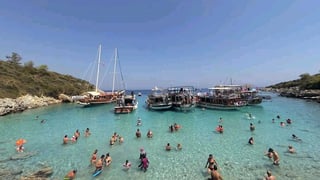
Orak Island, nestled in the Aegean Sea, is a picturesque Turkish island that sits opposite the historic town of Foça, once known as Phokaia in ancient times. Located in the Gulf of İzmir at coordinates 38°41′31″N 26°52′57″E, the island is just about 400 meters (1,300 feet) from the mainland. Spanning a length of 2 kilometers (1.2 miles) from north to south, Orak Island is shaped somewhat like a sickle, which is fittingly reflected in its name "orak."
The southern spit of the island, particularly reminiscent of a sickle's curve, might have inspired its intriguing name. There's a theory suggesting that the island's ancient name could have been "Bakkheion," hinting at a rich and possibly mystical past. Professor Ömer Özyiğit's surface surveys indicate that Orak Island was once bustling with life during the Classical period through to the Late Roman Empire. Among the notable historical remnants are three stone quarries, one of which is believed to have been a sacred site dedicated to the goddess Cybele, revered in ancient times.
This blend of natural beauty and historical significance makes Orak Island not just a scenic spot in the Aegean Sea, but a place echoing with the whispers of ancient civilizations.
Best Time to Island Hop in Turkey
Embarking on a journey to Turkey's captivating islands, nestled in the azure waters of the Aegean and Mediterranean Seas, is a venture best undertaken during the sun-drenched months of June through September. This period heralds the zenith of ferry operations, ensuring a seamless voyage to these secluded gems, accessible solely by the grace of the sea.
The rhythm of the ferry services begins to crescendo in mid-May, harmonizing with the awakening of the islands, and gradually decrescendos as mid-October approaches, signaling a time of quieter seas. Adventurers planning to explore these shores outside this window must navigate with foresight, as the tapestry of travel options becomes sparser.
Islands dedicated to the art of sightseeing, such as the historic Akdamar Island, cradled in the embrace of Lake Van in the eastern realms of Turkey, and the serene Gemiler Island, a jewel off the Mediterranean Coast, retreat into a tranquil hibernation during winter, with no public vessels charting their waters.
Moreover, islands that bask in the summer's embrace, transforming into vibrant havens for holidaymakers, witness a seasonal metamorphosis. As the tourist season – spanning May to September – ebbs away, so does the island life, with many local establishments pausing their services. This seasonal rhythm means that voyagers venturing during the off-peak months will encounter a more tranquil, albeit less abundant, selection of accommodations and culinary delights.
